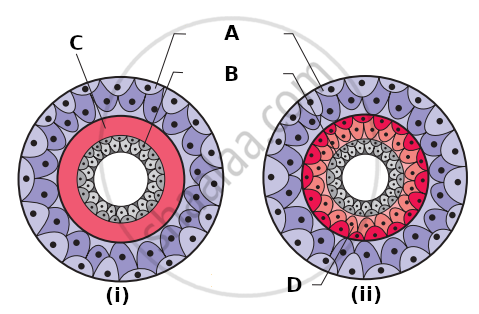Advertisements
Advertisements
प्रश्न
Match the following columns and select the correct option.
| Column – I | Column – II | ||
| (p) | Pila | (i) | Devil fish |
| (q) | Dentalium | (ii) | Chiton |
| (r) | Chaetopleura | (iii) | Apple snail |
| (s) | Octopus | (iv) | Tusk shell |
विकल्प
p – (ii), q – (i), r – (iii), s – (iv)
p – (iii), q – (iv), r – (ii), s – (i)
p – (ii), q – (iv), r – (i), s – (iii)
p – (i), q – (ii), r – (iii), s – (iv)
उत्तर
p – (iii), q – (iv), r – (ii), s – (i)
संबंधित प्रश्न
If you are given a specimen, what are the steps that you would follow to classify it?
How useful is the study of the nature of body cavity and coelom in the classification of animals?
What is the exact difference between grades of organization and symmetry? Explain with examples.
Complete the following chart.
| Body cavity | Germ Layer | Phylum |
| Absent | ______ | Porifera |
| Absent | Triploblastic | ______ |
| Pseudocoelom | ______ | Aschelminthes |
| Present | ______ | Arthropoda |
Write the correct co-relation:
Annelida: Earthworm :: Platyhelminthes: _______
Draw a neat and labelled diagram.
Jellyfish
The symmetry exhibited in cnidarians is ______.
Which of the following is a crustacean?
Identify the structure that the archenteron becomes in a developing animal.
Observe the animal below and answer the following questions.

- Identify the animal.
- What type of symmetry does this animal exhibit?
- Is this animal Cephalized?
- How many germ layers does this animal have?
- How many openings does this animal’s digestive system have?
- Does this animal have neurons?
What are flame cells?
Which organism is called Friends of farmers? Why?
Examine the figures of diploblastic (i) and triploblastic (ii) organization in animals given below and identify the labelled parts A to D.

In some animal groups, the body is found divided into compartments with serial repitition of at least some organs. This characteristic feature is called ______.
Match the following list of animals with their level of organisation.
| Division of Labour | Animal |
| Column I | Column II |
| A. Organ level | i. Pheretima |
| B. Cellular aggregate level | ii. Fasciola |
| C. Tissue level | ii. Spongilla |
| D. Organ system level | iv. Obelia |
Choose the correct match showing division of labour with animal example.
Identify the phylum in which adults exhibit radial symmetry and larva exhibit bilateral symmetry.
Provide appropriate technical term in the space provided.
Blood-filled cavity in arthropods ______.
Differentiate between open circulatory system and closed circulatory system
Sort out the animals on the basis of their symmetry (radial or bilateral) coelenterates, ctenophores, annelids, arthropods, and echinoderms.
What is the relationship between germinal layers and the formation of body cavity in case of coelomate, acoelomates and pseudocoelomates?
